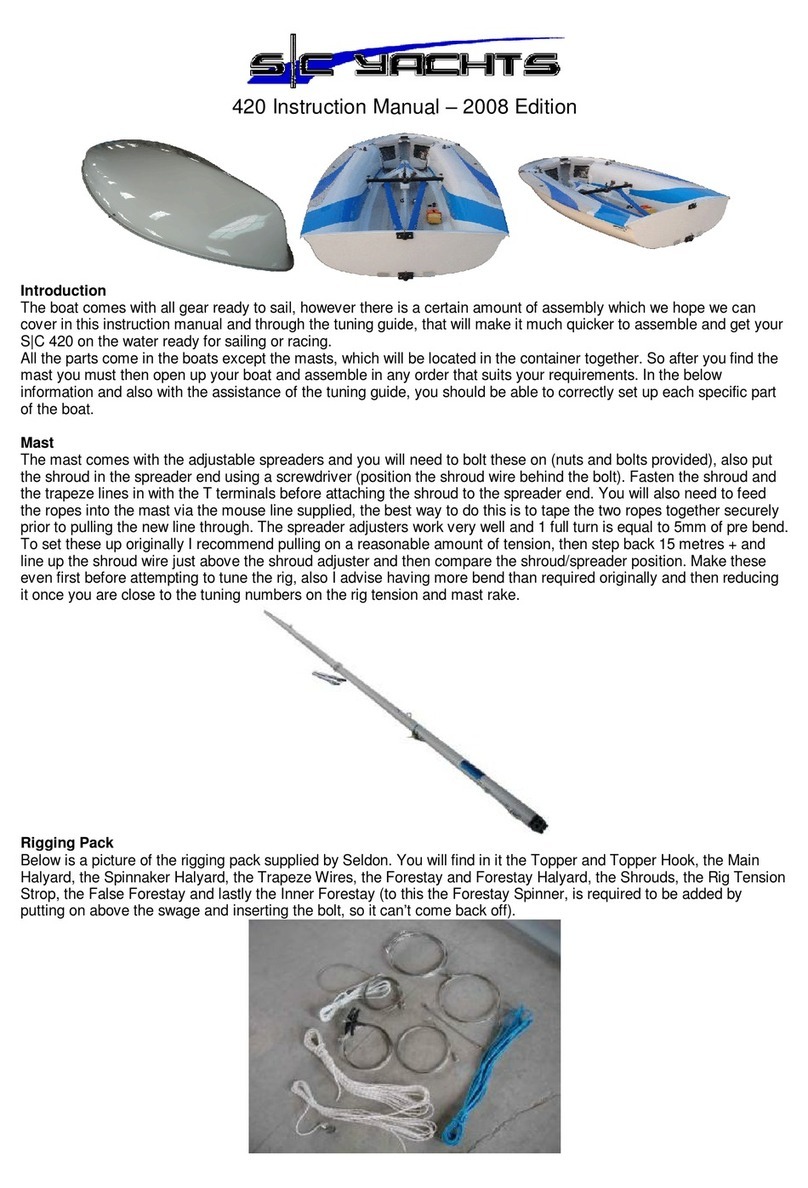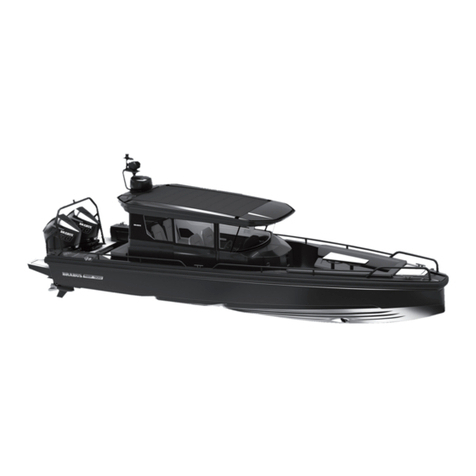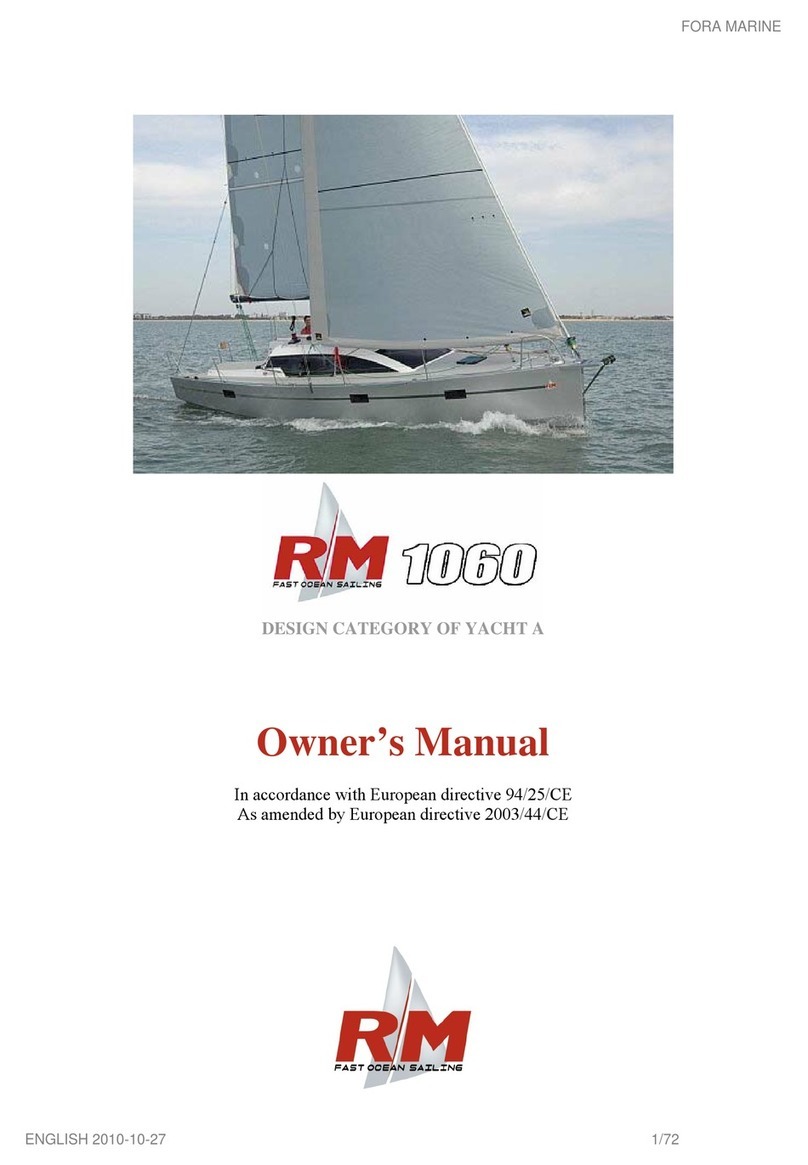Xo 270 RS CABIN User manual

1

2
WWW.XOBOATS.FI

3
XO BOATS
PREFACE
Congratulations on your new Finnish XO boat! We want to thank you for
choosing XO and we hope you enjoy the time you spend aboard.
The purpose of this manual is to help you operate your boat with safety
and pleasure. The manual contains the details of the boat and the associ-
ated or installed equipment and systems, as well as information on its oper-
ation and maintenance.
Please read the manual carefully and familiarise yourself with the boat before
using it. Naturally, you cannot learn the skills of seamanship and safe boating
by reading a User Manual. If this XO is your rst boat, or if you are changing
to a type of boat you are not familiar with, for your own comfort and safety
please ensure that you obtain handling and operating experience before
assuming command of your boat. Your dealer, boating clubs and national
sailing and yacht federations will be pleased to advise you of local boating
schools and competent instructors.
Make sure that your boat's design category is appropriate for the expected
wind and wave conditions, and that you and your crew are capable of han-
dling the boat in such conditions. The wind and wave conditions specied
for design category C may include gales and high winds, with risk of excep-
tional waves and gusts. Such conditions are dangerous and can be su-
ciently handled only by a competent and t crew in a well-maintained boat.
This User Manual is not a detailed maintenance or troubleshooting guide. If
a problem occurs, please contact your XO dealer. If a repair is required, use
only the companies recommended by your XO dealer.
KEEP THIS MANUAL IN A SAFE PLACE AND HAND IT OVER TO THE NEXT
OWNER IF YOU SELL THIS BOAT.

4

5
CONTENTS
1 BEFORE DEPARTURE 9
2 GENERAL 11
3 WARRANTY 12
4 BEFORE USING YOUR BOAT 12
4.1 Registration 12
4.2 Insurance 12
4.3 Training 12
5 BOAT CHARACTERISTICS AND OPERATION 13
5.1 General 13
5.2 Principal boat data 13
5.3 Maximum recommended number of persons 13
5.4 Load capacity 14
5.5 Engine and propeller 14
5.6 Flooding and stability 14
5.6.1 Openings in the hull and deck 14
5.6.2 Bilge pumps and drainage 14
5.6.3 Stability, buoyancy and otation 16
5.7 Minimising risk of re and explosion 16
5.7.1 Engines and fuel systems 16
5.7.2 Fire-ghting and prevention 17
5.8 Electrical system 18
5.9 Handling characteristics 22
5.9.1 Driving at high speed 22
5.9.2 Dead man's switch 23
5.9.3 Visibility from the steering position 23
5.10 Safe operation – other recommendations and information 24
5.10.1 Protection from falling overboard and means of 24
reboarding
5.10.2 Securing loose equipment 24
5.10.3 Respect for the environment 24
5.10.4 Anchoring, mooring and towing 26
5.10.5 Trailering 28
5.10.6 Navigation 28
6 Service, repairs and winter storage 29
7 Optional equipment 30
7.1 General 30
7.2. Installing optional equipment 30
7.2.1 Heater 30
7.2.2 Radio/CD player 30
APPENDIX 1 TECHNICAL SPECIFICATIONS 32
APPENDIX 2 XO 270 RS CABIN GENERAL LAYOUT 34
APPENDIX 3 GENERAL REQUIREMENTS 35
APPENDIX 4 WIRING DIAGRAM 36

6

7
BOAT MODEL: XO 270 RS CABIN
Craft Identication Number – CIN:
Engine make and model:
Engine serial number:
1ST OWNER
First name:
Last name:
Place of domicile:
Year of purchase:
2ND OWNER
First name:
Last name:
Place of domicile:
Year of purchase:
3RD OWNER
First name:
Last name:
Place of domicile:
Year of purchase:
4TH OWNER
First name:
Last name:
Place of domicile:
Year of purchase:
5TH OWNER
First name:
Last name:
Place of domicile:
Year of purchase:
6TH OWNER
First name:
Last name:
Place of domicile:
Year of purchase:

8

9
1 BEFORE DEPARTURE
Read this User Manual carefully.
Before each departure, check at least the following:
Weather and weather forecast
Take the wind, waves and visibility into account. Is your boat's design cat-
egory, size and equipment, as well as the skills of the helmsman and crew
adequate for the waters you are about to boat?
Load capacity
Do not overload the boat and always distribute the load properly. To avoid
diminishing your boat's stability, do not place heavy items too high up.
Passengers
Make sure that a life jacket is available for each person on board. Before
departure, agree on the tasks to be performed by each person during the
outing.
Fuel
Make sure that there is enough fuel on board, including a sucient reserve
in case of bad weather, for example. You should have at least a 20% reserve
to allow for the unexpected.
Engine and equipment
Check the operation and condition of steering, electrical devices and battery,
and perform all daily inspection procedures specied in the engine manual.
Check the boat's seaworthiness in general: check the boat for fuel and water
leaks, make sure that the necessary safety equipment is on board, etc. Check
that the bilge water level is at the minimum.
Ventilation
Make sure that the fuel tank compartment is properly ventilated to mini-
mise the risk of re.
Securing of equipment
Make sure that all items on board are secured so that they remain in place
in rough seas and high wind.
Nautical charts
If you are not fully familiar with the planned route, make sure that you have
nautical charts that cover a large enough area.
Departure procedures
Agree with the crew on whose task it is to detach each line, etc. Make sure
that the mooring lines or any other lines do not get caught in the propel-
ler during manoeuvring.
REFER TO THE SEPARATE ENGINE MANUAL FOR ADDITIONAL INSTRUC
TIONS ON THE ENGINE.

10

11
2 GENERAL
The purpose of this User Manual is to help you familiarise yourself with
the characteristics of your new boat. Separate manuals for the equipment
installed on the boat are attached and also referred to in a number of sec-
tions of this manual. Naturally, you can complement this manual with man-
uals of any device installed later on. There is also space reserved for your
own notes at the end of this manual.
The warnings and precautions in this manual are dened as follows:
DANGER!
Indicates a serious hazard that will most likely result in death
or permanent injury unless appropriate precautionary measures are taken.
WARNING!
Indicates a hazard that could result in injury or death unless
appropriate precautionary measures are taken.
NOTE!
Indicates a reminder of safe practice or directs attention to a
dangerous practice that could result in injury or damage to the boat or
its components.
The units used in this manual are in accordance with the SI system. In
some cases, however, other units are added in brackets. An exception to
the above is the wind force, which is expressed in the Beaufort scale in the
Recreational Craft Directive (RCD).

12
3 WARRANTY
This boat and the equipment installed by the boatbuilder are covered
by a warranty as specified in detail below. The engine, trim tabs, com-
pass, any navigation devices and other retrofitted devices are sub-
ject to any warranty of their respective manufacturers. Separate war-
ranty cards for these devices and appropriate supplier information are
included as an attachment. For other warranty issues, please contact your
XO dealer indicated on the front cover.
4 BEFORE USING YOUR BOAT
4.1 REGISTRATION
In many countries, even a small motor boat must be registered. Contact the
local authorities for the registration requirements in your country. To drive a
registered boat, one must usually meet the requirements for minimum age
and also possibly have a separate boat driver's licence.
4.2 INSURANCE
Boat insurance can cover for damage when the boat is in use, transported
or stored. Remember to check the insurance coverage separately for lifting
operations. Insurance also has an indirect eect on safety at sea: in the event
of a serious accident, you can focus fully on the essential – saving lives above
all else. More detailed information on various insurance alternatives is avail-
able from insurance companies.
4.3 TRAINING
There is a lot of boating literature available, and a great deal of benecial and
practical information can also be gained from boating clubs and by attend-
ing navigation courses. These can provide a sound basis for your skills, but
sureness in handling, navigating, mooring and anchoring the boat is only
acquired through practice.

13
5 BOAT CHARACTERISTICS AND OPERATION
5.1 GENERAL
This User Manual is not intended to be a comprehensive maintenance guide
or repair manual. Instead, the purpose is to help you familiarise yourself with
the characteristics of your new boat and show you how to use it properly.
5.2 PRINCIPAL BOAT DATA
XO 270 RS Cabin:
Boat type: XO 270 RS Cabin
Design category: C (inshore)
Maximum recommended load: 1,200 kg
See also Section 5.4 ‘Load capacity’
Design category C can be dened as follows:
Category C: The boat is designed for conditions in which the wind force does
not exceed 6 on the Beaufort scale (about 14 m/s)
and waves are consistent with the wind force (the signifi-
cant wave height must not exceed 2 m, with occasional waves
of 4 m maximum). Such conditions can occur in open water
on lakes, estuaries, and in coastal waters in moderate weather.
NOTE!
The signicant wave height is the average height of the highest third of
the waves. This roughly corresponds to an experienced observer's esti-
mate of the wave height. Waves of double this height may occasionally
be experienced.
Main dimensions and capacity:
The length, beam, draught, total weight, etc., and fuel tank capacity of the
boat are described in Appendix 1 ‘Technical specications’.
Builder's plate:
Part of the above information is indicated on the builder's plate attached
to the boat in the vicinity of the helm station. More detailed information is
given in the appropriate sections of this manual. Please note that, for exam-
ple, the maximum load capacity indicated on the builder's plate does not
include fuel, but the fuel is included in the maximum recommended load
specied by the manufacturer.
5.3 MAXIMUM RECOMMENDED NUMBER OF PERSONS
The maximum recommended number of persons on this boat is 10. The des-
ignated seating arrangement is shown in Figure 1.
WARNING!
Do not exceed the maximum recommended number of persons on board.
Irrespective of the number of persons on board, the total weight of the
persons and equipment must never exceed the maximum recommended
load (see Section 5.4 ‘Load capacity’). Always use the seats in the boat. If
your boat is not equipped with seats for 10 people, the passengers must
sit on the sole in the positions indicated in the gures.

14
5.4 LOAD CAPACITY
The maximum recommended load for XO 270 RS Cabin is 930 kg as indicated
on its plate. An adult's weight is taken to be 75 kg and a child's 37.5 kg. The
maximum recommended total weight of the persons on board is 750 kg.
In addition to the maximum recommended weight of persons mentioned
above, the boat can be loaded with the following: 40 kg of basic equipment
and 270 kg of fuel in the xed fuel tank. The recommended load includes
only the weight components specied above.
WARNING!
Never exceed the maximum recommended load when loading your boat.
Always load up the boat carefully and distribute the load properly so that
the designed waterline is maintained (approximately on an even keel).
Avoid placing heavy weight in a high position.
5.5 ENGINE AND PROPELLER
The maximum rated engine power for XO 270 RS Cabin is 273 kW (370 hp).
When starting the engine, check that the cooling water ows properly and
make sure that the gear is in the neutral position. If the engine starts when
the gear is not in neutral, contact your nearest service centre.
5.6 FLOODING AND STABILITY
5.6.1 Openings in the hull and deck
The XO boats are not equipped with plugs for draining the deck, but the
drain pipes are tted with shut-o valves. See the general layout of XO 270
RS Cabin (Appendix 2). XO 270 RS Cabin has four drain holes located on
the deck from where the rainwater is drained. In addition to the rainwater,
the drain holes are intended to drain water ending up on the deck through
splashing or from breaking waves. The drain holes must be open at all times.
Clean out the holes regularly by removing any accumulated debris to pre-
vent clogging.
NOTE!
The self-draining deck system is intended to drain the majority of rainwa-
ter and water ending up on the deck through splashing or from breaking
waves. A portion of the rainwater and water condensing in the bilge may
end up in the bilge. DO NOT LEAVE THE BOAT UNATTENDED IN WATER FOR
LONG PERIODS. PAY ATTENTION TO THE FLOATING POSITION OF THE BOAT
AND DRAIN THE BILGE WHEN NECESSARY. Leaving the boat unattended in
water for a long period may lead to damage.
5.6.2 Bilge pumps and drainage
The location of draining devices is shown in Figure 2. The bilge pumps are
positioned as close to the bottom plate as is practically possible. Despite
this, it is completely normal that a small amount of water remains in the
bilge so that it cannot be discharged by the bilge pump. XO 270 RS Cabin
is equipped with an automatic, electric bilge pump. It discharges water

15
Loading and seating
(Figure 1)
Bilge pumps and drainage
(Figure 2)
Seat
Electric bilge pump
Manual bilge pump
Bilge pump intake and intake hose
Bilge pump discharge hose

16
accumulated in the bilge when the level sensor detects water. The auto-
matic pump is always in the standby mode irrespective of the main switch
position, provided that the battery is connected. The bilge pump starts
when the sensor has been fully submerged for 5 seconds, and stops once
the sensor does not detect water. The pump can also be activated man-
ually with the spring-loaded switch located on the switch panel. Reg-
ularly check the electric bilge pump inlet and remove any debris. You
can access the bilge pump through the service hatch in the engine well.
WARNING!
The bilge pump system is not designed to deal with a leak
resulting from running aground or other damage.
NOTE!
Check the amount of bilge water by emptying the bilge manually with
the spring-loaded switch located on the switch panel every time before
use. We recommend you to have at least one bucket or bailer on board.
NOTE!
Regularly check the operation of the bilge pump. If you notice that the
bilge pump does not operate properly, remove any debris from the pump
inlet and contact your XO dealer if necessary.
5.6.3 Stability, buoyancy and otation
The stability of your XO boat is excellent due to its hull design and weight
distribution. However, remember that high breaking waves always repre-
sent a serious danger to stability. Also note that the stability of your boat
will be compromised if any weight is placed in a high position. All changes
in the positioning of dierent weights in the boat can have a signicant
impact on the stability, trim and performance of your boat. If you are plan-
ning such changes, please contact the boat manufacturer. The amount of
bilge water should be kept at a minimum because freely moving water in
the boat always impairs the boat's stability. Also note that stability can be
diminished when towing or being towed.
5.7 MINIMISING RISK OF FIRE AND EXPLOSION
5.7.1 Engines and fuel systems
The XO 270 RS Cabin is equipped with a xed fuel tank, which is located in
the centre section of the bilge area. Shut down the engine before refuelling.
Do not smoke or use a naked ame. Do not use any electrical devices. The
fuel llers are located on both sides of the boat, above the deck drain holes.
Lift the spare fuel tank out of the boat for refuelling to prevent fuel from get-
ting in the bilge in case of overll. When you refuel in a fuel station, do not
use a plastic funnel that will prevent discharge of static electricity between
the pump nozzle and ll tting. After lling the tank (for the tank capacity,
see Appendix 1‘Technical specications’), check that no fuel has leaked into
the bilge or engine compartment, and immediately remove any spilled fuel.
You can visually check the condition of the fuel hoses through the service
hatch. Do not keep spare fuel canisters in an unventilated space or have
them loose in the boat, and do not keep any equipment containing fuel in
a place that is not specically designed for it. At least once a year, visually

17
check the condition of the hoses through the service hatch.
5.7.2 Fire-ghting and prevention
Whenever the XO 270 RS Cabin is used, it must be equipped with re extin-
guishers with a minimum re rating of 8A 68B. The minimum re rating for an
individual re extinguisher is 5A 34B. A hand-held re extinguisher is located
in the front section of the port seat console, on the left-hand side of the stor-
age compartment, as shown in Figure 3. You must have the hand-held re
extinguishers inspected regularly at specied intervals, depending on the
legislation in your country. Contact the local re authorities for the inspec-
tion policy in your country. If you are unsure of the inspection policy in your
country, have your hand-held re extinguishers inspected once a year. The
manufacturing date of a hand-held re extinguisher is indicated on a label
attached to the re extinguisher. Fire extinguishers that are more than ten
years old will not be approved unless the pressure vessel is pressure tested
again. When replacing a hand-held re extinguisher, it must be replaced with
an extinguisher with an extinguishing capacity that is at least the same as the
old one. The owner/user of the boat should make sure that there is at least
one easily accessible re bucket with a line attached to it. Make sure that all
re-ghting equipment is easily accessible when the boat is loaded. Inform
all crew members of the location and operation of the re-ghting equip-
ment. Keep the bilge free of fuel and check the fuel system for leaks regularly.
Fuel smell is a sure sign of a fuel leak. If your boat is equipped with a heater,
refer to the heater manufacturer's instructions for its safety instructions.
SPECIAL WARNINGS
Never
• obstruct access to the safety equipment, re extinguisher, fuel valves or
main switch
• block any ventilation openings as they are designed to vent out any fuel
vapour.
Also, never
• make changes to your boat's electrical or fuel system, or allow an unqual-
ied person to make changes to any system on the boat
• ll the fuel tank or handle fuel when the engine is running
Location of re extinguishers
(Figure 3)
Automatic re extinguisher; Sea Fire 100A Automatic
Hand-held re extinguisher; 2 kg

18
• smoke or use a naked flame when handling fuel
• keep fuel in a space that is not designed for such purpose. If the boat
is not equipped with a heater, a spare fuel tank can be stored in place of
the heater's tank.
• leave the boat unattended when a cooker or heater is in use.
5.8 ELECTRICAL SYSTEM
The boat's wiring diagram is shown in Appendix 3. The main switch is located
on the starboard side, behind the helm station. However, the automatic bilge
pump is always operational when the battery is connected. When the cir-
cuit is closed, the various devices can be operated with the switch panel at
the helm station.
The navigation lights are switched on with the running light switch (see Fig-
ure 5). Remember to install the removable mast light in position. Windscreen
wipers on either side of the boat are operated with appropriate switches. To
check the amount of bilge water, activate the bilge pump with its switch (see
Figure 5). If you cannot hear the sound of water owing beside the boat at
the stern, the automatic system has drained the water properly.
The electrical system is pre-tted for adding various optional equipment,
and is fully tted for adding a radio/CD player and two speakers. The boat
is also partially tted for adding a fuel-burning heater.
The layout of controls and electrical equipment is shown in Figures 4 and 5.
The fuses for electrical circuits are located in a separate fuse panel inside
the helm console (see Figure 4). The XO boats are equipped with automatic
fuses. If such a fuse is tripped as a result of overload, you can easily reset it
by pushing down the fuse button that has popped up. The electrical system
has two additional circuits,‘Extra 1’ (10 A) and‘Extra 2’(10 A) (wiring diagram
positions F13-F14 and F17-F19). These circuits are protected with fuses and
are designed for connecting retrotted optional equipment. The wires for
these circuits can be found in the switch panel. Do not replace the fuses with
fuses that have higher current ratings, and do not add components to the
electrical system so that the circuit's nominal amperage rating is exceeded.
Zinc anodes are installed on the transom. Replace the anodes when they are
over 50% of their original size.
WARNING!
Never use the hull for earthing. Both the negative and positive sides of all
electrical installations must be insulated from the hull.

19
Electrical equipment
(Figure 3)
Location of electrical equipment:
Battery compartment
Main switch
Bilge pump
Mast light, white, 360°
Navigation lights, red and green
Switch panel
Power outlet, 12 V, max. 10 A
Fuse panel (see Figure 6)
Windscreen wiper

20
CONTROLS
(Figure 5)
Switch panel:
Horn
Navigation lights
Deck light
Search light
Windscreen wiper (port)
Windscreen wiper (starboard)
Windscreen washer
Defroster
Bilge pump
AUX
Bow thruster
Engine control handle
Trim tab controls (starboard and port)
Automatic re extinguisher indicator light
Ignition key
Table of contents
Other Xo Boat manuals
Popular Boat manuals by other brands

Pakboats
Pakboats XT-15 solo Assembly instructions and user's manual
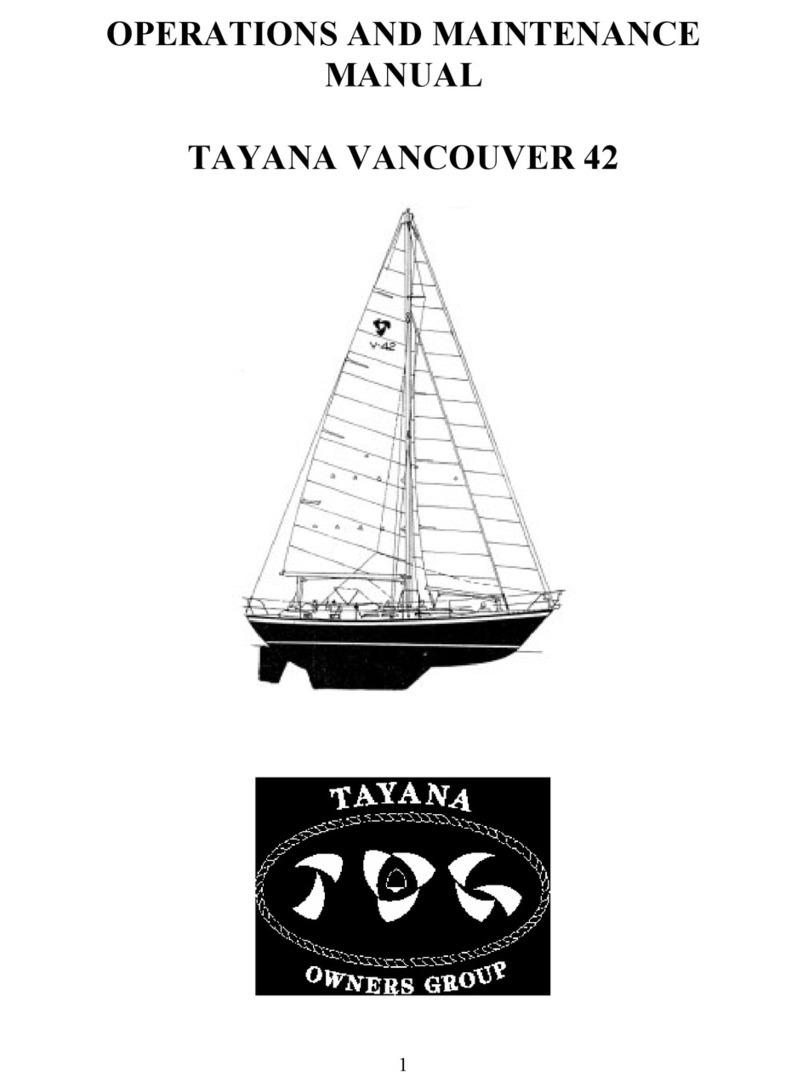
Tayana
Tayana VANCOUVER 42 Operation and maintenance manual
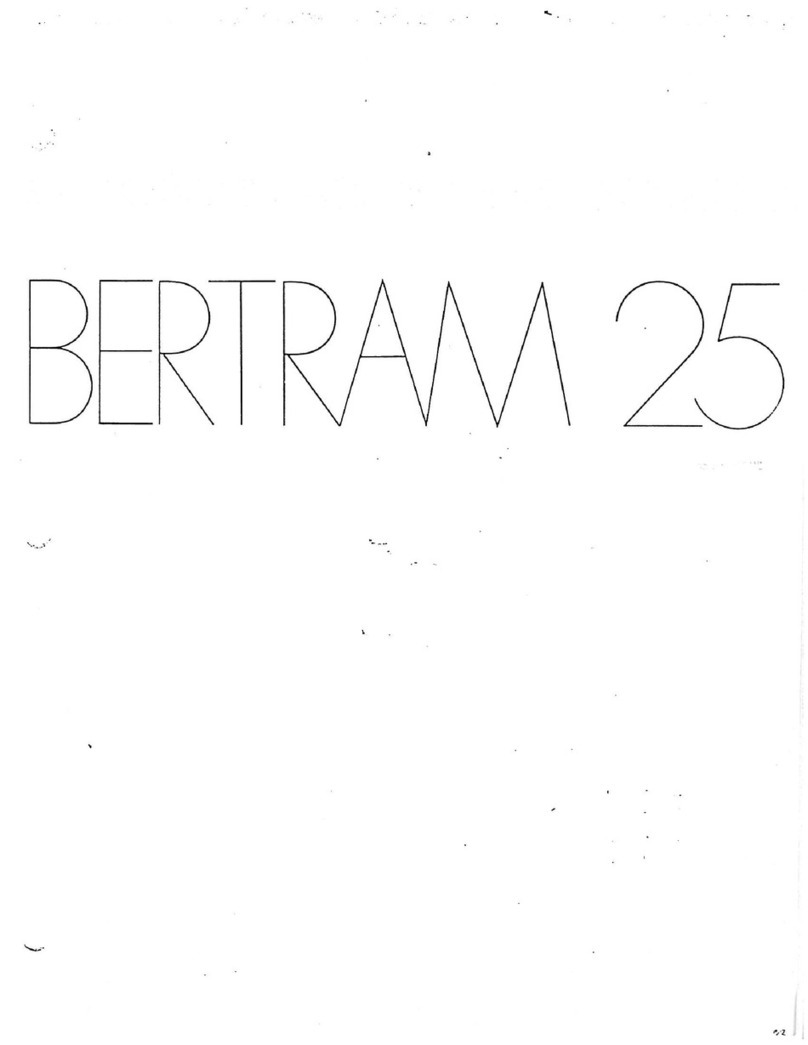
Bertram
Bertram 25 owner's manual
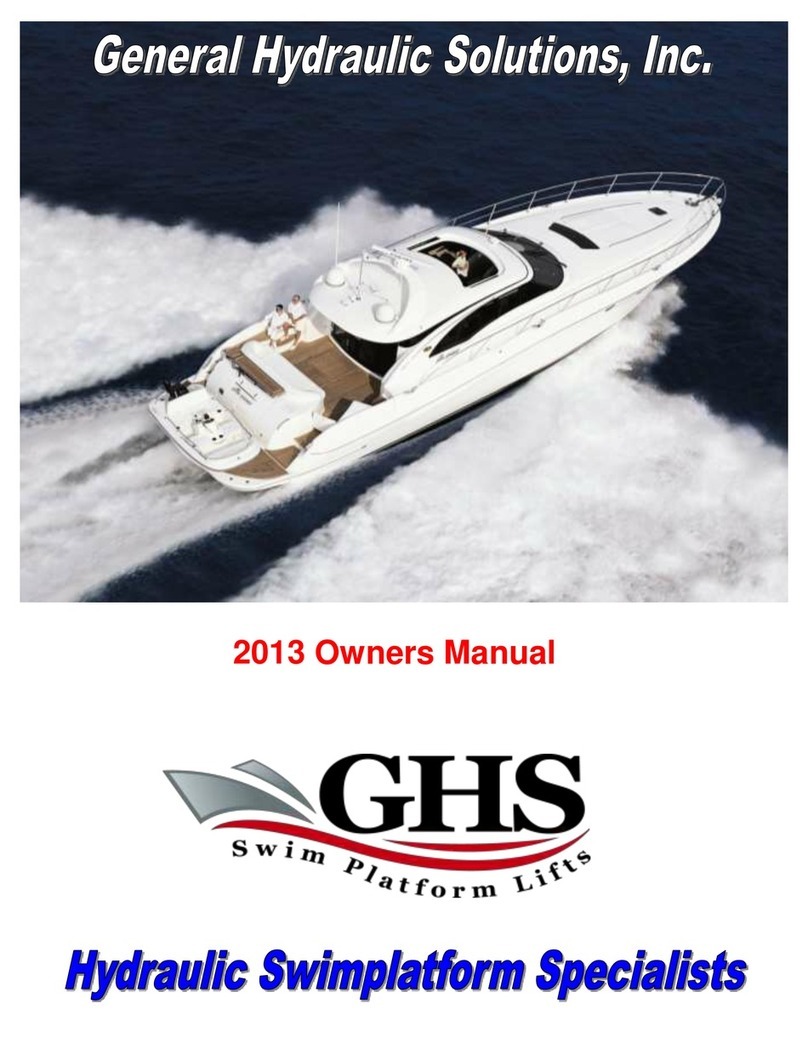
GENERAL HYDRAULIC SOLUTIONS
GENERAL HYDRAULIC SOLUTIONS 2013 owner's manual
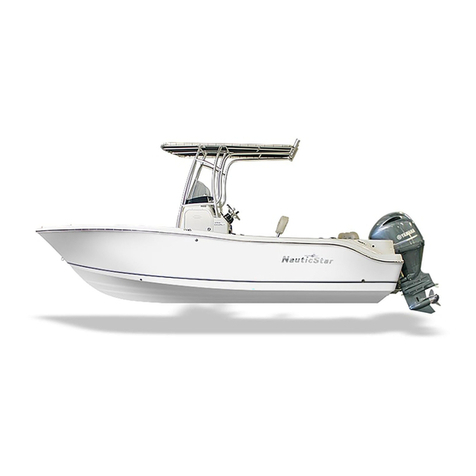
Nauticstar
Nauticstar Legacy Series owner's manual
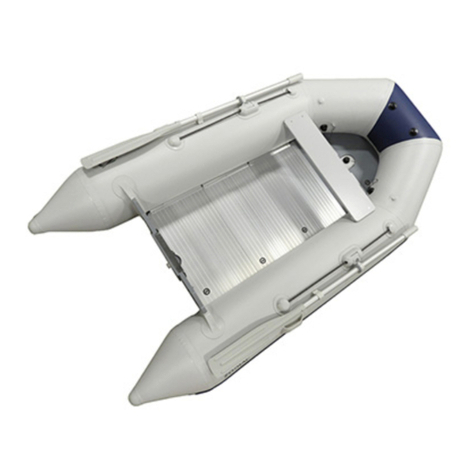
Zodiac
Zodiac WAVE 275 Roll Up owner's manual
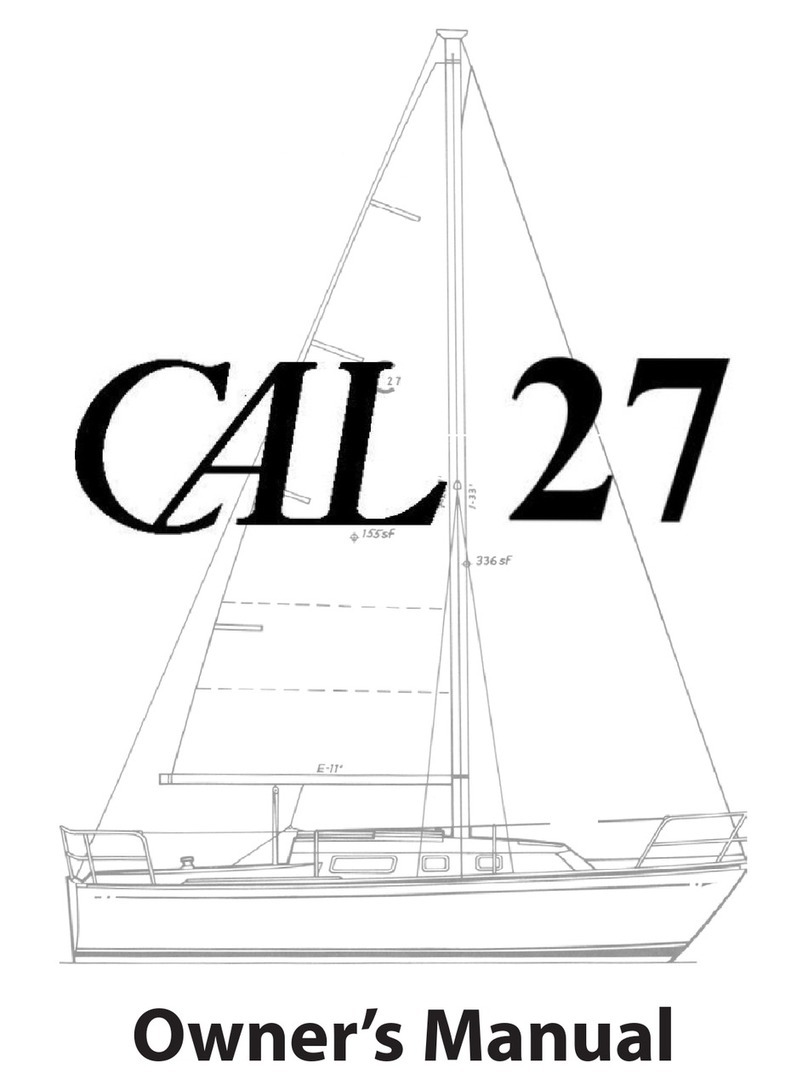
Cal Boats
Cal Boats CAL 27 Mk III owner's manual

West Wight Potter
West Wight Potter Cruising vessel user manual

FUNAIR
FUNAIR SUPER SWEET SLIDE instruction manual

Zodiac
Zodiac MilPro Futura Commando FC 420 owner's manual

JETSURF
JETSURF ULTRA SPORT user manual
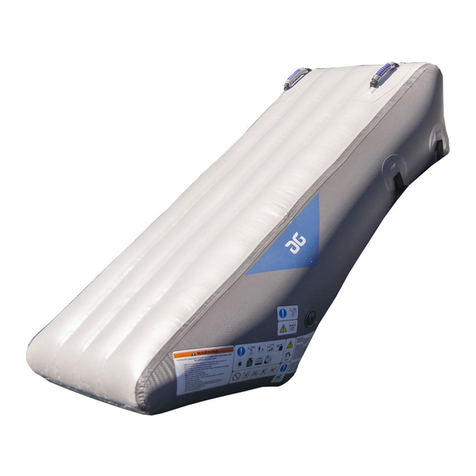
Aquaglide
Aquaglide 12-14 Slide (small) owner's manual




